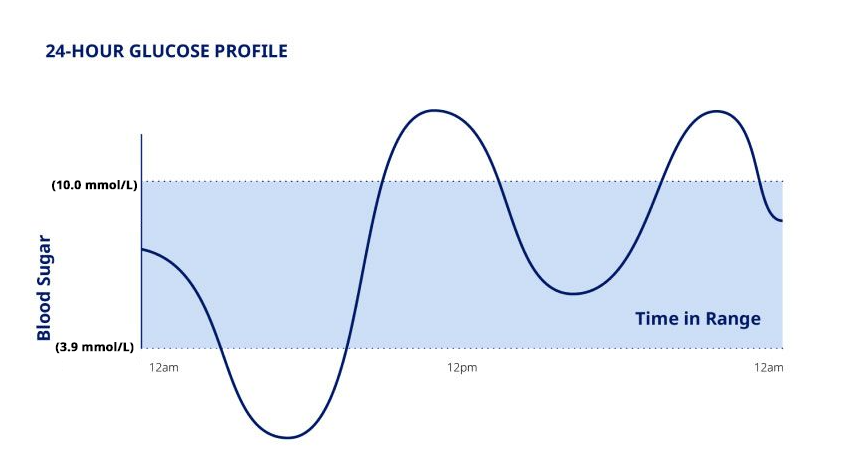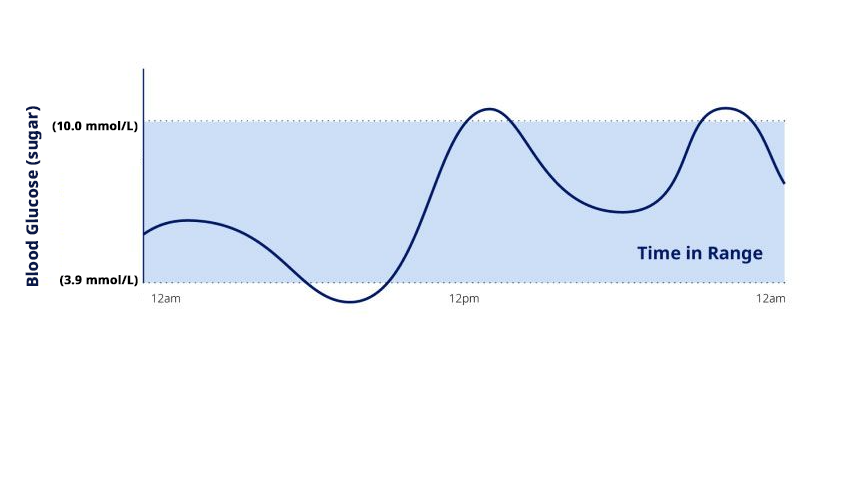
Digital Health
Digital technology is advancing in every aspect of life and managing diabetes is no exception
Find out how you can use both these blood glucose measurements together to get a better grip on your diabetes.
Together with HbA1c, Time in Range can help you and your healthcare professional to get a more complete picture of your blood glucose over time and help reduce your risk of health complications.1,2,3
HbA1c gives your average blood glucose over three months1 and Time in Range adds to this by giving you results over 24-hour periods.1
HbA1c is a traditional and useful measure of blood glucose control but there are some things it cannot show, such as the daily fluctuations in your blood glucose levels that can be responsible for low blood glucose (hypoglycaemia) or high blood glucose (hyperglycaemia). For people who use a continuous glucose monitor (CGM), the peaks, dips and daily fluctuations in blood glucose can be seen.1
Read on to find out how Time in Range can work together with HbA1c by providing a more complete picture of your blood glucose control.1
This quick-reference guide shows you how to read TiR from a special report on your CGM

HbA1c is a useful measure that shows your average blood glucose levels for the previous three months.1 In other words, it gives you a historical average of your blood glucose levels over a three-month period. HbA1c is generally seen as the ‘gold standard’ in diabetes management and has been used for a long time.4 It is the best-known and best-studied measurement, but some scientists are starting to think that Time in Range could be a better indicator of your risk of diabetes complications over time.1,2,5
Unlike with CGM use, HbA1c cannot show you the 24-hour fluctuations in your blood glucose or any peaks and dips.1 In fact, people with the same HbA1c results could have very different blood glucose patterns.4,6
Here is an example:
Two people with the same HbA1c can have different blood glucose patterns.
Both Peter and Christina appear to have good diabetes blood glucose control, as their HbA1c test results were both 7%, but a closer look shows a different picture.6 This extra information is vital to help make those small but important lifestyle and behavioural changes needed to live well with diabetes.1
Diagrams are for illustrative purposes only
Short animation of the differences between Time in Range and HbA1c
Time in Range gives a more complete picture of your blood glucose control; a personalised view that shows how long you spend in your target blood glucose range (between 3.9–10 mmol/l, for most people).1 Experts recommend that if you have type 1 or type 2 diabetes, most people should try to spend at least 17 hours (70%) of their day within this range.1 Different people may have slightly different targets for both HbA1c and TiR.1,2 Talk to your doctor to understand what your target range is.
We now know that it is not just periods of high blood glucose levels (hyperglycaemia) that increase the risk of diabetes-related health problems, but also when blood glucose levels fluctuate. The more time you spend above and below range, the greater your risk of complications such as damage to your eyes and kidneys, and even heart attack or stroke.2,3
HbA1c can be used to predict your risk of developing these health complications, and aiming for an HbA1c of below 7% can reduce this risk.2,3
The more time you spend in your target blood glucose range (TiR), the more likely you are to reduce your diabetes health risks.1,2,3
HbA1c and TiR are measured differently. HbA1c is measured using a diabetes blood test which must to be sent to a laboratory. Time in Range is measured during your everyday life using the numbers from a continuous glucose monitoring device (CGM).1 A CGM checks your ’interstitial’ glucose levels without you having to prick your finger or take any blood, using a sensor attached to your body.2 Interstitial glucose sounds complicated, but all it means is that the monitor measures the sugar level in the fluid under your skin but does not measure your blood glucose directly.2 The recent dramatic advances in digital health for diabetes and ‘diabetes tech’ have proved that CGMs can be very successful in helping people with diabetes stay within their target healthy blood glucose range.7
Time in Range is not replacing HbA1c, but it can provide extra information to help support you and your healthcare professional to manage your diabetes.1,2,4 Some people with diabetes find it helpful to understand how their treatment and lifestyle are affecting their blood glucose levels. This knowledge can help them stay motivated with their diabetes management.8
Both TiR and HbA1c are very helpful tools to support you and your diabetes care team to make informed decisions that work for you and your health now and in the future.
February 2024. IE23DI00203



